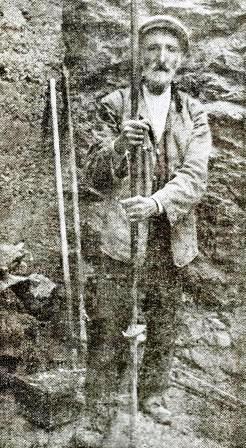Vegetarianism has become a popular way of life in the last decades, with the growing awareness of its nutritional benefits, and with the consolidation of the revolutionary notion that animals are not commodities, but living beings that possess the right to live, just like human beings. However, very few people are aware that the story of vegetarianism in Israel began years ago, in the beginning of the 20th century. The man that laid the foundations for the vegetarian movement in Israel was Nathan Ben Zion Havkin.
Nathan Havkin was born in Khotimsk, White Russia. He was merely 17 when the Jews of Khotimsk were deported, and his family settled in Odessa. There, he began to study painting, and also became acquainted with Zionist ideas. He joined Hovevei Zion, and made plans to immigrate to Palestine after the Second Zionist Congress, but after meeting the writer Mendele Mocher Sforim , he was exposed to broader, more cosmopolitan intellectual trends, such as pantheism. Instead of immigrating to Palestine he moved to Munich, where he studied graphics. In 1900 he opened a workshop for wooden printing blocks in the city. In Munich, he became an ideological vegetarian and a pacifist. His humanist and universalist worldview made him adopt another ideology – an ideological language, to be precise – Esperanto, the language that Zamenhof introduced, aimed to bring mankind together by toppling linguistic barriers.
After anti-semitism seeped into the vegetarian groups in Munich, Havkin founded "Brit Daniel" – a Jewish vegetarian association. He endeavored to further the cause of Esperanto through this association too. In 1921 he immigrated to Palestine, and five years later founded the "Hebrew Vegetarian Association in the Land of Israel". He gathered like-minded friends, such as Rabbi Binyamin (Yehoshua Radler Feldmann), one of religious Zionism's most prominent figures, who was also active in Brit Shalom . The association published a journal, "The Vegetarian", in which it published articles about vegetarianism. Havkin and Rabbi Binyamin were among the writers.

In Palestine, Havkin became an avid promoter of an agricultural way of life. And, indeed, he practiced what he preached: he settled in Givat Shaul, than a desolate settlement near Jerusalem, and set up a farm by himself, while fighting a war of attrition against the recalcitrant rocky terrain. He dug a well and carved out a cave on his land that served him as a shed. But he had an even bigger plan for the grounds near his plot: he aimed to set up the first vegetarian settlement in Palestine.
New Givat Shaul
Haim Aharon Valero was a Jewish philanthropist who was very influential in the development of Jerusalem. He died in the 1930's. His estate included 120 acres of land, situated very close to Havkin's farm. In 1933, in the philanthropic spirit of its owner, the plot was offered for free to any Hebrew association that would be able to found a new Jewish settlement on it. Havkin's Hebrew Vegetarian Association happily took on the challenge. The name of the future settlement was to be Givat Shaul Hahadasha (New Givaat Shaul), and plans, as well as elaborations regarding the vegetarian ideology it would live by, were published in the association's journal of that year.
Givat Shaul Hahadasha never left the realms of an ambition. But visionaries should not be judged by their own accomplishments, but by the extent to which they influence those who come after them. In 1958, Yehezkel Doron, one of Havkin's students, founded Amirim in the Upper Galil, a vegetarian settlement that exists to this day, in the spirit of Havkin's ideological vision.